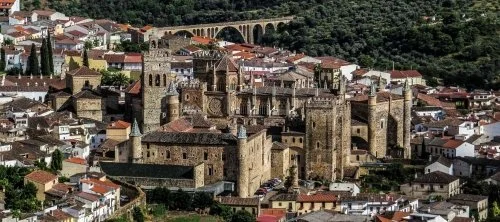Guadalupe de Cáceres
The Virgin of Guadalupe
Patronness of Extremadura
Queen of Hispanics
Our Lady of Silence
In her sanctuary, the monastery of Guadalupe, near Cáceres, Extremadura on the Portuguese border.
Legend has it that this image belonged to St. Luke the Evangelist and was buried with him when he died. In the fourth century St. Luke's remains, with his statue, were brought to Constantinople. Later Pope Gregory the Great (c. 540 - 604) brought the statue to his private chapel in Rome. Soon this Virgin performed her first great miracle. It was during an outbreak of the plague that the people carried her in a great procession through the streets of Rome and with intense religious fervor asked her to stop this punishment. That day the epidemic ceased while an angel was seen on the castle cleaning a blood stained sword.
After Gregory's death, the image was given to St. Leander, archbishop of Seville. It was venerated in his cathedral until the Moorish invasion in 711. In 714 some clergymen who were fleeing from the Muslims took the Virgin with them and buried her in an iron casket near the river Guadalupe (Hidden River).
After six hundred years, Our Lady of Silence was ready to emerge from yet another grave. By now the area was Christianized again. One day a poor cowherd from Cáceres by the name of Gil found one of his cows dead. He decided to skin it for the leather. But when he had made the first incision in the form of a cross, the cow suddenly revived and at that very moment the Queen of Heaven appeared and addressed Gil thus:
"Don't be afraid. I am the Mother of God, savior of the human lineage. Take your cow and bring it to the rest of your herd. Then go home and tell the clerics what you saw and that I sent you to them. They are to come to this place where you are now and to dig where your dead cow was. Under those rocks they will find an image of me. And when they take it out, tell them not to move it from the place where it is now, but to build a little house right here and put the image in it."¹
With those words the Virgin disappeared. When Gil came home he found out that one of his sons had just died. He invoked the Mother of God he had spoken with earlier and the child revived. This sign convinced the clerics of the veracity of Gil's story. Immediately they complied with the Virgin's instructions and dug up the perfectly preserved sacred image together with documents attesting her origins.
A little hermitage was built and entrusted to the Franciscans who wrote this story down. Over the centuries they also collected nine codices, kept in the monastery archives, that list the miracles attributed to this Virgin of Guadalupe.
the sanctuary & town photo source
One of the early Franciscan monks at the monastery of Guadalupe became Zumarago, the bishop of Mexico City to whom the Mother of God sent Juan Diego with news of yet another Marian apparition. Supposedly the Lady in Mexico told Juan Diego her name was Coatlaxopeuh (pronounced Quatlasupe), which some translate to mean She who Crushes the Serpent.² Sounded like Guadalupe to the man from Guadalupe.
The basilica of O.L. Gudalupe de Caceres photo source
The monastery of Guadalupe must be the richest sanctuary in the Hispanic world, because for centuries, just like a worldly queen, the Virgin of Guadalupe had the right to demand alms and part of the inheritance of well-situated people.³ All that wealth was not only used to adorn her church-palace and throne room but also to accommodate her pilgrims and take care of their needs. At one point four major and seven minor hospitals, a school of medicine and music, pharmacies, libraries, pilgrims' hostels, and scriptoriums formed part of her sanctuary. It is a magnificent center for Hispanic culture and religion.
8 Biblical strong women surround the Black Madonna photo source
An interesting detail mentioned in the “Visitor’s Guide” sold in the sanctuary, in the chapter “the Virgin’s Shrine”: The Black Madonna is surrounded by eight “Strong Women” in the niches around her altar: Miriam the prophetess, Deborah the judge, Jael, (who killed Sisera, the commander of the Canaanite army) Sarah the matriarch, Ruth (the Moabite great grandmother of King David, Abigail (King David’s second wife, whom he loved for her wisdom, courage, assertiveness, and eloquence), Queen Esther and Judith (both of whom saved the Israelites at different times and in very different ways).
She is also surrounded by plenty of holy men, but they don’t seem to be important news to the Franciscan monk Sebastian Garcia O.F.M. who wrote the text of the 2005 edition. You couldn’t possibly describe every image in this gigantic basilica, but these 8 women stand out.
9 sybils on the outside of the Holy House of Mary,
home of the Black Madonna of Loreto, Italy photo source
This reminds me of the Holy House of Mary in Loreto, Italy, the home of one of the most celebrated Black Madonnas. Its outside is adorned with the nine sybils, Pagan prophetesses who are said to have foretold the Messiah. – It seems that our generation is not the first to have seen Black Madonnas as an expression of an honorable, very strong femininity. Nor are we the first to celebrate such femininity, complementary and in contrast with the meek and humble type preferred by most patriarchs.
Footnotes:
1. www.centenarioguadalupe.org, Historia de la Imagen.
2. Actually we don't know exactly with what name Our Lady introduced herself to Juan Diego in his native Nahuatl language. Several versions and interpretations are discussed in www.livingmiracles.net/Guadalupe.html, scroll down to "Origin of the Word Guadalupe".
3. www.centenarioguadalupe.org, La Devoción a Santa María de Guadalupe.






